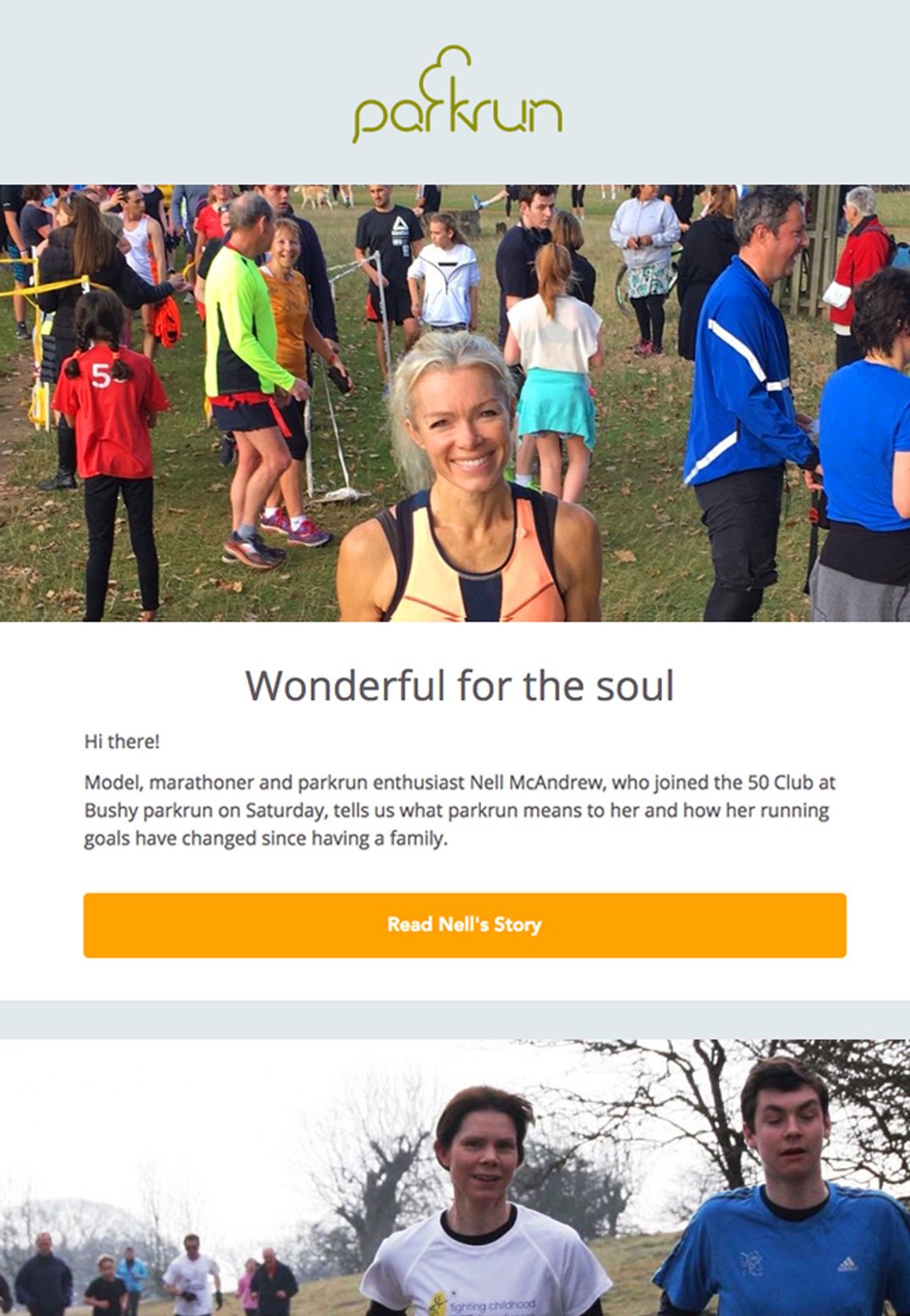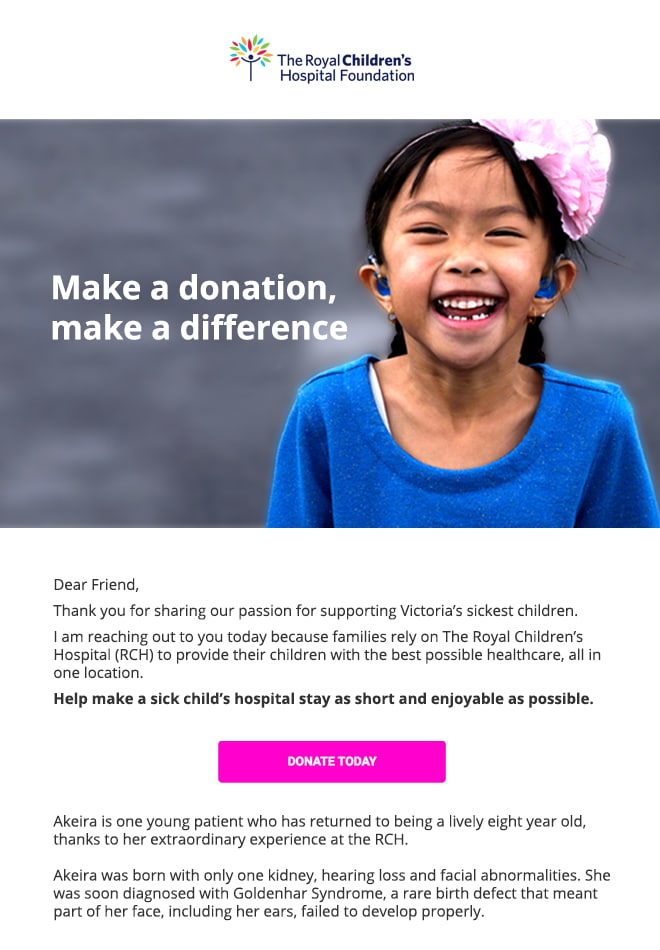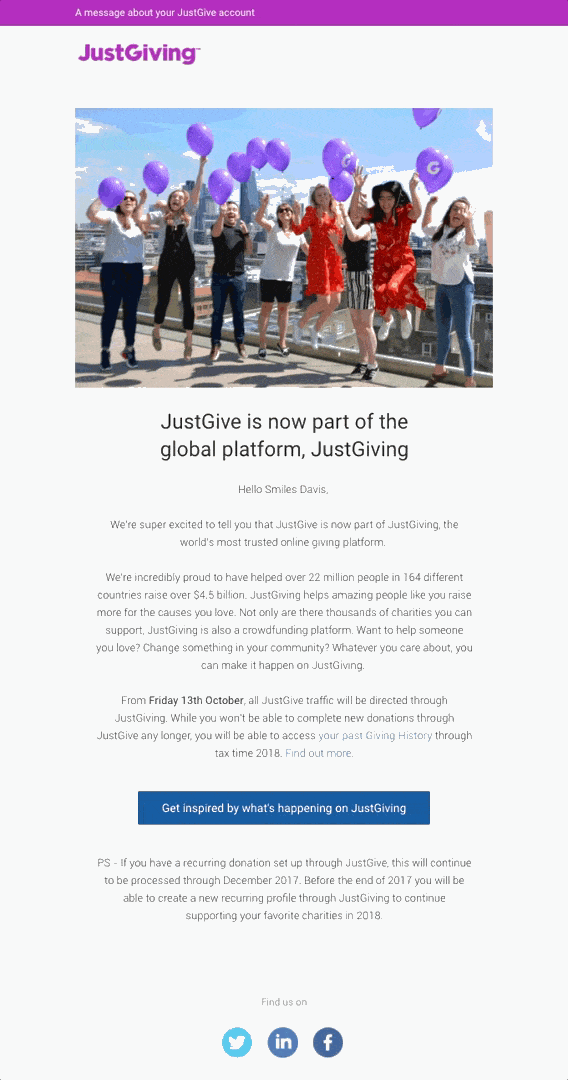Updated September 2019
Nonprofit email marketing continues to be a central spoke in the wheel of donor and constituent outreach. Direct mail lives on as a significant source of donations, but email marketing brings in its own share of donations and fills in all the communication gaps at an incredibly lower cost.
Some reports show average nonprofit email open rates as high as 34%, which makes email marketing an important force for nonprofits.
If you’re reading this, it’s probably because you already understand the value of email and just want to know what to include in your email newsletters, welcome emails, donation receipts, and donation appeals. That puts you way ahead of many nonprofits that don’t yet see the value in email marketing.
Give yourself a pat on the back, and then start adding these items into every email marketing campaign you send out to your supporters.
1. Recognizable sender
One easy way to drive loyalty, support, and higher email open rates is to make your nonprofit emails come from a recognizable and consistent person or entity. Since you can choose your sender, it’s up to you to determine who your emails should be from.
Adjusting the sender is a great thing to aggressively test what resonates, and then occasionally test after you find a winner. Here are some ideas to try out:
- Send from your organization. This is a straightforward and authoritative approach. If the recipient signed up for your newsletter or donated in the past, they’ll recognize the name of your nonprofit and have an incentive to open your email.
- Send from your founder, executive director, or president. If your organization’s founder or leader is a recognizable person, this is a great way to instill trust and consistency in your email marketing campaigns.
- Send from your development director. This can be a powerful tactic if your development director has been around for a long time and handles most of the donor relations, especially if they’re the ones that write letters or call donors from time to time, This will make your emails seem like messages from a friend.
2. Subject line test
Most—if not all—of your emails should be testing out subject lines. You may be able to decrease your testing after you’ve tested for a while and have declared winning subject guidelines. But until that point, test away. See some subject line test ideas here.
3. Compelling content
Including compelling content in your email marketing doesn’t just mean emotional, and it doesn’t just mean inspiring. Both of those qualities are important (vital, even), but compelling means something more directed.
What’s the goal of your email? Is it to drive advocacy after a donation and ensure retention? Is it to drive an initial donation? Or to sign up for an event? Even a monthly or weekly newsletter should have goals, like building loyalty and trust with your donors to grow your retention rate.
Whatever the goal of your email marketing campaigns, your content should point to this goal and compel your subscribers to take action. This means that your content should be emotional and inspiring, yes—but also directed, stimulating, and convincing.

Here are some elements of an email you can include or improve to make your content more compelling:
- Images from your field work. Showing photos or videos of the work you’re doing and the people, places, or animals you’re affecting. These are instantly emotive, showing a clear connection between what you’re fundraising for and how donations are being used.
- Stories from beneficiaries or volunteers. These two types of stories can inspire different responses. Sharing a story from someone who is receiving help can inspire a reader to donate or get involved and continue making a difference in people’s lives. Similarly, hearing from a volunteer about their experience supporting the mission can help readers relate and see themselves helping in that way.
-

- Quote about the work being done. While not all of your emails can tell an entire story, every one of them can have a strong quote in the footer of your email. This can be from a beneficiary, the founder, a volunteer, news coverage, or other sources. This quote should be short (ideally one quick sentence) and powerful. If you don’t have access to any good quotes, consider asking volunteers, supporters, and team members for quotes you can use.
4. A donation button or link
One of the primary reasons you’re engaging with your supporters via email is probably to engender more donations. It should always be easy for someone to find your donation page, whether that’s on your Facebook page, website, or in your email marketing.
This is an easy thing to do when you’re sending a newsletter or appeal for a new campaign. You can insert the main content and then include a button at the end of the text that takes them to your online donation page. This is a no-brainer and should be included whenever it’s appropriate.

For the times that a big donation button in your email isn’t appropriate, consider having a consistent footer that has a link to donate.
Thank-you emails are a great example. After a donation is processed (online or offline), your donor should receive a thank-you email. Now that they’re receiving this email after they just donated to your cause, this probably isn’t an appropriate time to ask them for another donation.
So for all your non-appeal emails (thank-you emails, transactional emails, welcome emails, registration confirmations, etc.) consider adding a link to donate in the footer of your email. This can be as simple as a statement about your mission and a small donate button or link to your website.
For example, in this email from MS Society, their statement “Let’s stop MS together” in the footer gives context to exactly what their goal as an organization is. They then provide links to appropriate channels to support the fight against MS.

5. Simple personalizations
Emails with personalized subject lines are 26% more likely to be opened. Creating personalized experiences can increase revenue by 20%. There are many more statistics that prove the power of personalization and why you should be utilizing it to drive donor interaction. But the big takeaway is to start personalizing,
The easiest way to start is to test out first names in the subject line. Adding this type of personalization is especially useful when sending donation receipts. But personalizations can be significantly more powerful when using integrations. Integrating donor data from your CRM (like Salesforce or Raiser’s Edge), you can personalize each email sent out by pulling in a piece of their donation history.
This works really well to retain your donors. You can remind them of their exact gift in the year previous (pulling in data from your donor database), and tell them about the impact that gift could have again this year.
Another great way to personalize communication is based on campaigns the donor has given to in the past. If you have a variety of campaigns or ways for supporters to get involved with your nonprofit, you could tailor your newsletters to include content or news around the specific campaigns supported by each person.
6. A mobile version
Mobile viewership continues to grow, and your email marketing campaigns and templates need to grow, too. There are tons of reasons why you need to embrace the way of mobile (see our guide here). But while most nonprofit email marketers agree that designing for mobile is important, they tend to forget about it.
It’s very easy to design your email marketing campaign, go through your preflight checklist, and then hit send, all the while forgetting to even take a look at the mobile version of your email. With so many recipients viewing your emails on a mobile device, this is a costly mistake.
One way to combat this forgetfulness is to always have a designated mobile tester. When you’re sending your usual email tests around the office, designate at least one of those people to always open the email on their phone. Ensuring at least one set of eyes has looked at the mobile version will catch any weird formatting issues before your mobile viewers become disinterested with your email marketing.
7. Metric tracking
Most email service providers should offer metrics and analytics to review deliverability, open rates, click-through rates, and other data points automatically (see Campaign Monitor’s analytics tools here). But there are a few extra steps to take if you want to make the most out of your email marketing.
- Set goals for your campaigns. Goals will look different from campaign to campaign (your goal for thank-you emails should be different than your goal for a Giving Tuesday campaign), but make sure you 1) have them and 2) track them. For example, track the growth of your click-through rates to donating, and how much is being donated through your emailed appeals.
- Track through to your database. Being able to view whether a donor has opened an email you sent them or not is huge. This will impact your segmentation and personalization with great dividends, showing you which constituents are the most plugged into your cause. Connect your email service provider to your CRM or database for better insights.
- Track the entire donation experience. Your nonprofit needs to use Google Analytics to measure traffic on your website. By monitoring your website traffic, you can see where donors came from, which pages they visited, and how much they gave as a result. This is an incredible metric for email marketing, as you can see how much giving you’re able to generate from specific email campaigns. This will help you track the return on investment for your email marketing, and see which campaigns drive more donations.
5 tips to help you take your nonprofit email marketing to the next level
Nonprofit organizations should take advantage of some of the hacks traditional businesses use to improve their conversions.
1. Send an automated series.
is a powerful strategy that can help you keep in touch with your donors regularly. One way you can optimize this powerful strategy is by sending your readers an automated email series. One way you can do this is to create an email series telling the story of your organization, vision, and mission. Doing so will help boost brand awareness. It’s also a great way to connect with your donors on a deeper level.
2. Integrate with social media.
Another way of increasing the impact of your emails is to integrate your email marketing with social media. Place share buttons in your emails to enable your readers to easily share your emails with their network. You could also include a link to a landing page or blog post in your email and ask your donors to donate their time by sharing the link to their family and friends.
Source: Really Good Emails
3. Include a personal note from a high-ranking member of staff.
People need to feel appreciated, especially when partnering with a cause they’ve chosen to support. One way you can let your donors know you appreciate them is by including a personal note from a superior member of staff (like a director), including a signature as well. These are small touches that make your email more personal. Your donor will feel like the email was sent by a person, not an organization.
4. Use powerful images.
Make it easier for your donors to relate to the cause they’re supporting by including powerful images in your emails. These can be photos of your staff on the ground or the people/cause you’re fighting for. Since most of your readers aren’t able to visit the places they’re serving, give them a glimpse of what’s happening on the ground. Images are a great way to motivate them to give more.
Source: Really Good Emails
5. Pay attention to your design.
Email design plays an important role in the way your email is received by your readers. You only have a few milliseconds to make an impact and convince the recipient to read it. If the design is cluttered, chances are that your reader won’t bother reading—let alone sharing—your email. A well-designed email is bound to encourage readers to read through and even respond to your CTAs.
For more in-depth information on the design aspect, take a look at our nonprofit marketing guide.
Wrap up
Email marketing can be a huge support to your mission and donor base. Combined with traditional outreach like phone calls, handwritten letters, and direct mail, email marketing can keep your supporters feeling connected and ultimately drive more donations and advocacy. All this can be accomplished with flying colors by keeping this list of seven items tied to every campaign you send.
Ready to improve your fundraising efforts with powerful email marketing? See how Campaign Monitor helps nonprofits reach their fundraising goals.








